
Joye M.Cryptographic hardware and embedded systems.2005
.pdf
346 H. Mamiya, A. Miyaji, and H. Morimoto
RPA, and ZPA together with some known countermeasures. Section 3 presents our new countermeasures, the basic countermeasure (BRIP) and the generalized countermeasure with a pre-computed table (EBRIP). Section 4 presents the performance of our strategy compared with the previous RPA-, ZPA-, and SPA-resistant countermeasure.
2Preliminary
This section summarizes some facts of elliptic curves like coordinate systems and reviews power analysis of SPA, DPA, RPA, and ZPA together with some known countermeasures.
2.1Elliptic Curve
Let  be a finite field, where
be a finite field, where  is a prime. The Weierstrass form of an elliptic curve over
is a prime. The Weierstrass form of an elliptic curve over  is described as
is described as
The set of all points |
|
satisfying E, together with the point of infinity |
|
is denoted by |
which forms an abelian group. Let |
and |
|
be two points on |
and |
be the sum. |
|
Then the addition formulae in affine coordinate are given as follows [5].
 Addition formulae in affine
Addition formulae in affine 

where 
 Doubling formulae in affine
Doubling formulae in affine 
where 
Let us denote the computation time of an addition (resp. a doubling) in the affine
coordinate by |
|
(resp. |
and represent multiplication (resp. inverse, |
||
resp. squaring) in |
by M (resp. I, resp. S). Then we see that |
||||
|
and |
|
|
|
Both addition and doubling formulae |
need one inversion over |
which is much more expensive than multiplication |
||||
over |
Therefore, we transform affine |
into other coordinates, |
|||
where the inversion is free. We give the addition and doubling formulae with
Jacobian coordinate, which are widely used. |
|
|
In the Jacobian coordinates [5], we set |
and |
giving the |
equation |
|
|
TEAM LinG
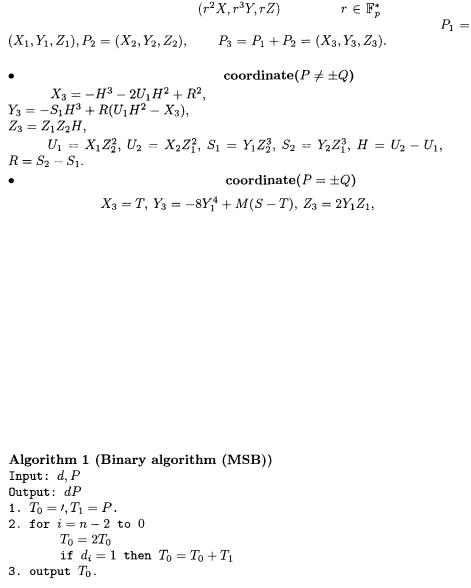
Efficient Countermeasures Against RPA, DPA, and SPA |
347 |
||
Then, two points (X, Y, Z) and |
for some |
are recognized |
|
as the same point. The point at infinity is represented with (1,1,0). Let |
|
||
and |
|
The doubling |
|
and addition formulae can be represented as follows. |
|
|
|
Addition formulae in Jacobian |
|
|
|
where |
|
|
and |
Doubling formulae in Jacobian |
|
|
|
where  and
and 
The computation times in the Jacobian coordinate are  and
and  where
where  means Jacobian coordinates.
means Jacobian coordinates.
Elliptic curve cryptosystems often execute the elliptic curve exponentiation of  where
where  and
and  is an
is an  integer. The simple method to compute dp is a so-called binary algorithm. Algorithm 1 shows the binary algorithm to compute dP from MSB, where the binary expansion of
integer. The simple method to compute dp is a so-called binary algorithm. Algorithm 1 shows the binary algorithm to compute dP from MSB, where the binary expansion of  is
is
 Average computing complexity of Algorithm 1 is
Average computing complexity of Algorithm 1 is
where A and D denotes the computation amount of addition and doubling, respectively. When we compute dP from LSB, we have to keep another point  instead of
instead of  but can apply the iterated doubling formulae in Jacobian coorinate [11], which computes
but can apply the iterated doubling formulae in Jacobian coorinate [11], which computes  for
for  by
by However, the binary algorithm from LSB is not easily generalized to a sophiticated method
However, the binary algorithm from LSB is not easily generalized to a sophiticated method
with a pre-computed table.
2.2Power Analysis
There are two types of power analysis, the simple power analysis (SPA) and the differential power analysis (DPA), which are described in [15,16]. In the case of elliptic curve and also hyper elliptic curve, DPA is further improved to use a special point with a zero value, which is called the Refined Power Analysis (RPA) [10]. RPA is generalized to the Zero-value Point Analysis (ZPA) [2]. In this paper, DPA, RPA, and ZPA are called DPA variants generically.
TEAM LinG

348 H. Mamiya, A. Miyaji, and H. Morimoto
Simple Power Analysis. SPA makes use of such an instruction performed during an exponentiation algorithm that depends on the data being processed. Apparently, Algorithm 1 has a branch instruction conditioned by a secret exponent  and thus it reveals the secret
and thus it reveals the secret  In order to be resistant against SPA, any branch instruction of exponentiation algorithm should be eliminated. There are mainly two types of countermeasures: the fixed procedure method [6] and the indistinguishable method [3]. The fixed procedure method deletes any branch instruction conditioned by a secret exponent
In order to be resistant against SPA, any branch instruction of exponentiation algorithm should be eliminated. There are mainly two types of countermeasures: the fixed procedure method [6] and the indistinguishable method [3]. The fixed procedure method deletes any branch instruction conditioned by a secret exponent  like add-and-double-always method [6], Montgomery-ladder method [23], and window-based method [18]. Add-and- double-always method is described in Algorithm 2. The indistinguishable method conceals all branch instructions of exponentiation algorithm by using indistinguishable addition and doubling operations, in which dummy operations are inserted.
like add-and-double-always method [6], Montgomery-ladder method [23], and window-based method [18]. Add-and- double-always method is described in Algorithm 2. The indistinguishable method conceals all branch instructions of exponentiation algorithm by using indistinguishable addition and doubling operations, in which dummy operations are inserted.
Differential Power Analysis. DPA uses correlation between power consumption and specific key-dependent bits. Algorithm 2 reveals  by computing the correlation between power consumption and any specific bit of the binary representation of 4P. In order to be resistant against DPA, power consumption should be changed at each new execution of the exponentiation. There are mainly 3 types of countermeasures, the randomized-projective-coordinate method (RPC) [6], the randomized curve method (RC)[13], and the exponent splitting (ES) [3,4]. RPC uses the Jacobian or Projective coordinate to randomize a point
by computing the correlation between power consumption and any specific bit of the binary representation of 4P. In order to be resistant against DPA, power consumption should be changed at each new execution of the exponentiation. There are mainly 3 types of countermeasures, the randomized-projective-coordinate method (RPC) [6], the randomized curve method (RC)[13], and the exponent splitting (ES) [3,4]. RPC uses the Jacobian or Projective coordinate to randomize a point  into
into  or
or  for a random number
for a random number  respectively. RC maps an elliptic curve into an isomorphic elliptic curve by using an isomorphism map of
respectively. RC maps an elliptic curve into an isomorphic elliptic curve by using an isomorphism map of  to
to  for
for  However, all these two methods are vulnerable against RPA and ZPA, which will be described in Section 2.2. The only method secure against RPA and ZPA is ES, which splits an exponent and computes
However, all these two methods are vulnerable against RPA and ZPA, which will be described in Section 2.2. The only method secure against RPA and ZPA is ES, which splits an exponent and computes  for a randomly integer
for a randomly integer 
Refined Power Analysis and Zero-value Point Attack. DPA is specialized to reveal a secret key  by using a special elliptic-curve point with a zero value, which is defined as
by using a special elliptic-curve point with a zero value, which is defined as  or
or  These special points of
These special points of  and
and  still have a zero value like
still have a zero value like  and
and  even if it is converted into the projective coordinate, respectively. This is why special points can not be randomized by RPC or RC, and an adversary can thus make use of a zero value in
even if it is converted into the projective coordinate, respectively. This is why special points can not be randomized by RPC or RC, and an adversary can thus make use of a zero value in
TEAM LinG
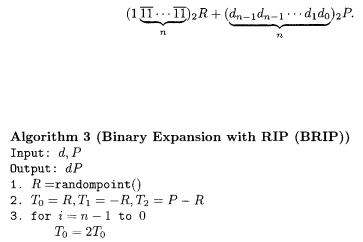
Efficient Countermeasures Against RPA, DPA, and SPA |
349 |
the execution of exponentiation. A countermeasure to RPA are proposed in [30], but this is not a universal countermeasure, gives each different method to each type of elliptic curves, and is still vulnerable against ZPA, described below.
RPA is generalized to ZPA by [2], which makes use of any zero-value register in addition formulae, which is not randomized by RPC or RC. The addition and doubling formulae have a lot of each different operations stored in auxiliary registers, one of which may become zero. ZPA uses the difference in any zero value register between addition and doubling.
We may note that ES can resist both RPA and ZPA because an attacker cannot handle an elliptic curve point in such a way that any special point with zero-value value can appear during an execution of exponentiation algorithm.
3Efficient Countermeasures Against SPA and DPA Variants
In this section, we propose a new countermeasure against all DPA variants.
3.1Our Basic Countermeasure
Here we show our basic countermeasure, called BRIP. Our method uses a random initial point (RIP) R, computes dP + R, and subtracts R to get dP. By using a random initial point at each execution of exponentiation, any point or any register used in addition formulae changes at each execution. Thus, it is resistant against DPA, RPA, and ZPA. In order to be secure against SPA, we have to compute dP + R in such a way that it does not have any branch instruction dependent on the data being processed. Our remarkable idea lies in a sophisticated combination to compute dP + R from MSB by the same complexity as Algorithm 2: first let 1 express  and apply the extended binary method [17] to compute
and apply the extended binary method [17] to compute
Algorithm 3 shows our idea in detail. We get dP by computing dP + R and subtracting R. BRIP makes all variables  and
and  dependent on a random point R, and thus let all variables of each addition and doubling differ at each execution.
dependent on a random point R, and thus let all variables of each addition and doubling differ at each execution.
TEAM LinG
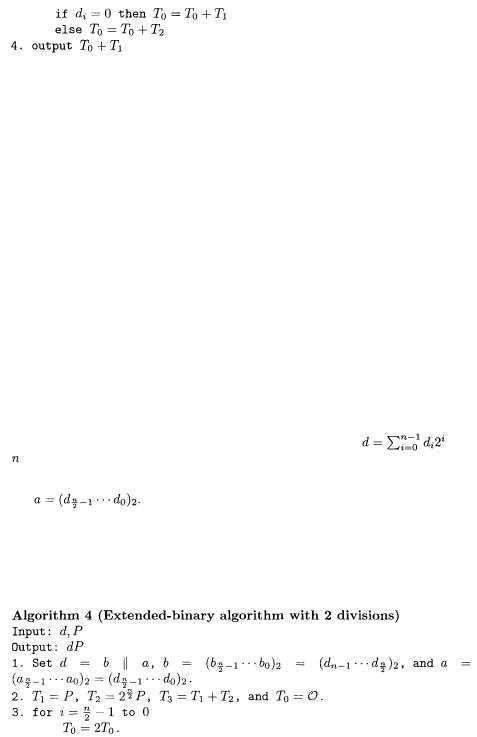
350 H. Mamiya, A. Miyaji, and H. Morimoto
We discuss the security, the computation amount, and the memory amount. BRIP lets the power-consumption pattern be fixed regardless of the bit pattern of a secret key  and thus it is resistant against SPA. The resistance against DPA depends on the method of generating a random initial point R. The simplest way to generate R is to generate the
and thus it is resistant against SPA. The resistance against DPA depends on the method of generating a random initial point R. The simplest way to generate R is to generate the  randomly and compute the corresponding
randomly and compute the corresponding  if exists. It should require much work. The cheaper way is to keep one point
if exists. It should require much work. The cheaper way is to keep one point  and convert
and convert  into a randomized point R by RPC [12]. If R is chosen randomly by some ways mentioned above, BRIP can be resistant against DPA, RPA, and ZPA, since any special point or zero-value register can not appear during each execution. The computation amount required for Algorithm 3 is nD + nA, which is the same as Algorithm 2. The number of variables necessary for computation is only 3.
into a randomized point R by RPC [12]. If R is chosen randomly by some ways mentioned above, BRIP can be resistant against DPA, RPA, and ZPA, since any special point or zero-value register can not appear during each execution. The computation amount required for Algorithm 3 is nD + nA, which is the same as Algorithm 2. The number of variables necessary for computation is only 3.
3.2Our Generalized Countermeasure
Our basic countermeasure BRIP can be generalized to a faster method with a pre-computed table since BRIP makes use of the binary expansion from MSB. We may note that the binary expansion from LSB can not be easily generalized to a faster method with a pre-computed table.
As for methods of using a pre-computed table, there are mainly two methods: the window method [18] and the extended binary method [17,32]. The extended binary method is originally used to compute two exponentiations aP+bQ, which
is applied to compute one exponentiation as follows [32]. Let |
and |
be even. |
|
1.Divide  into two components of
into two components of  where
where  and
and
2.Compute
3.Set a pre-computed table {P, Q, P + Q}.
4.Compute aP + bQ in the extended binary method by using the pre-computed table.
The detailed algorithm is shown in Algorithm 4.
TEAM LinG
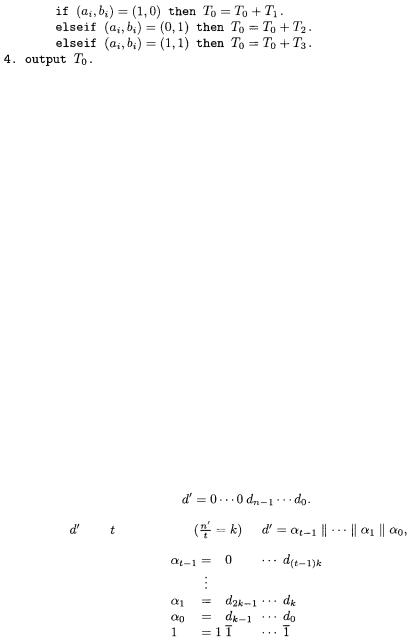
Efficient Countermeasures Against RPA, DPA, and SPA |
351 |
Going back to the countermeasure using a pre-computed table, it is necessary for both the extended binary and window methods to make power-consumption pattern same in order to be resistant against SPA. In the case of the window method, some SPA-resistant methods are proposed in [21,22,24]. However, all of these are not resistant against RPA or ZPA even if they are combined with the methods of RC and RPC. In the case of the extended binary method, up to the present, any SPA-resistant method has not been proposed.
Our generalized method is both SPA and DPA-variant resistant, which is able to reduce the computation amount with a pre-computed table. Our sophisticated idea lies in the length of representation of  which is adjusted to be applied on any bit length of
which is adjusted to be applied on any bit length of  and output the same executed pattern, while holding down the additional compuation and memory amount. As a result, our method is SPA-resistant naturally. In the following, two algorithms based on the extended-binary and the window methods are described. The extended-binary- based method is more efficient than window-based method although extendedbinary method usually does not work on a single exponentiation as efficient as the window method.
and output the same executed pattern, while holding down the additional compuation and memory amount. As a result, our method is SPA-resistant naturally. In the following, two algorithms based on the extended-binary and the window methods are described. The extended-binary- based method is more efficient than window-based method although extendedbinary method usually does not work on a single exponentiation as efficient as the window method.
Our extended-binary-based method with RIP. Let us show our extended- binary-based method with RIP, which is called EBRIP for short.
1.Choose a random point R.
2.Let the number of divisions be t.
3.Adjust  to be the least common multiple
to be the least common multiple  of
of  and
and  by setting 0 to MSB of
by setting 0 to MSB of  where
where
4. Divide into components |
of |
that is, |
5.Compute  for
for  to
to  (Set
(Set 
6.Compute a pre-computed table  which consists of
which consists of  points.
points.
7.Compute  in the way of the extended binary method.
in the way of the extended binary method.
TEAM LinG
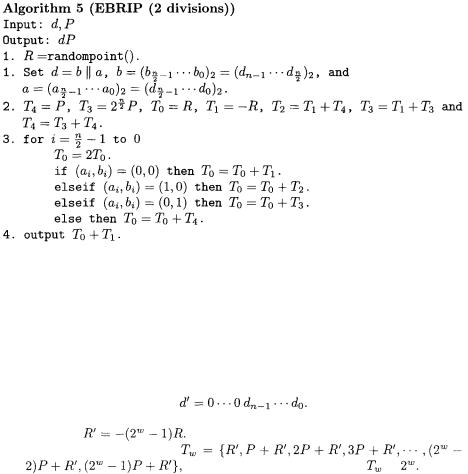
352 H. Mamiya, A. Miyaji, and H. Morimoto
Algorithm 5 shows the case of  and an even
and an even  for simplicity. Let us discuss the resistance, computation amount, and memory amount. As for SPA, the power-consumption pattern is not changed for any initial point R and any secret key
for simplicity. Let us discuss the resistance, computation amount, and memory amount. As for SPA, the power-consumption pattern is not changed for any initial point R and any secret key thanks to the expansion of 1, and EBRIP is thus secure against SPA. We may note one remarkable point that the length of expansion of 1 is not fixed to
thanks to the expansion of 1, and EBRIP is thus secure against SPA. We may note one remarkable point that the length of expansion of 1 is not fixed to  but adjusted to
but adjusted to  As a result, it realizes more efficient computation than the window-based method. Moreover, under the assumption that an initial point R is completely random, EBRIP is secure against DPA, RPA, and ZPA, as we mentioned in Section 3.1. As for the computation amount, EBRIP consists of these parts: compute base points
As a result, it realizes more efficient computation than the window-based method. Moreover, under the assumption that an initial point R is completely random, EBRIP is secure against DPA, RPA, and ZPA, as we mentioned in Section 3.1. As for the computation amount, EBRIP consists of these parts: compute base points  a pre-computed table
a pre-computed table  and the main routine. The computation amount for base points,
and the main routine. The computation amount for base points,  or main routine is
or main routine is  or
or  respectively. Thus, the total computation amount
respectively. Thus, the total computation amount
is  On the other hand, the number of points in
On the other hand, the number of points in  is
is  which includes a random point R. EBRIP needs one more point of variable to execute. Thus, the necessary memory is
which includes a random point R. EBRIP needs one more point of variable to execute. Thus, the necessary memory is  in total.
in total.
Our window-based method with RIP. Our window-based method with RIP is summarized as follow, which is is called WBRIP for short.
1.Choose a random point R.
2.Set the width of window to be 
3.Adjust  to be the least common multiple
to be the least common multiple  of
of  and
and  by setting 0 to MSB
by setting 0 to MSB  of
of  where
where
4.Compute
5.Set a pre-computed table
where the number of points in |
is |
TEAM LinG
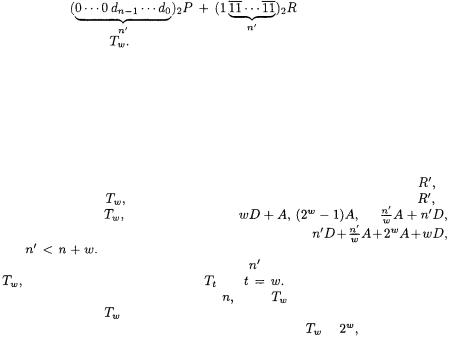
Efficient Countermeasures Against RPA, DPA, and SPA |
353 |
|||
6. Compute |
in the |
way |
of window |
|
method by using |
|
|
|
|
Let us discuss the security, |
the computation amount, |
and |
the |
memory |
amount. Power-consumption pattern is not changed for any random R and any secret key  thanks to the expansion of 1. This is why WBRIP is resistant against SPA. This means that WBRIP is secure against SPA without any additional modification on the window method seen in [21,22,24]. Furthermore, under the assumption that an initial point R is completely random, our method is resistant against DPA, RPA, and ZPA. Next we investigate the computation amount of
thanks to the expansion of 1. This is why WBRIP is resistant against SPA. This means that WBRIP is secure against SPA without any additional modification on the window method seen in [21,22,24]. Furthermore, under the assumption that an initial point R is completely random, our method is resistant against DPA, RPA, and ZPA. Next we investigate the computation amount of
WBRIP. WBRIP consists of three parts: compute an intermediate point |
a |
|||||||
pre-computed |
table |
and main routine. The computation amount of |
a |
|||||
pre-computed |
table |
or main routine is |
|
|
or |
|
||
respectively. Therefore, the total computation amount is |
|
|
|
|||||
where |
|
|
It is not as efficient as the extended-binary-based method |
|||||
since the length of expansion of 1 is fixed to |
to reduce the number of points |
|||||||
in |
which is the same as that in |
for |
If we change the length of |
|||||
expansion of 1 to a shorter length like |
then |
must |
include other |
points |
||||
and thus the size of |
becomes larger. Finally we discuss the memory amount |
|||||||
necessary to execute WBRIP. The number of points in |
is |
which includes |
||||||
a random point R. Additional one variable is necessary for computation. Thus, the necessary memory is  points in total.
points in total.
As a result, compared with EBRIP, WBRIP needs more computation amount with the same memory amount.
4Performance
From the point of view of computation and memory amount, we compare our countermeasures BRIP and EBRIP with the previous method ES [4], which are resistant against SPA and DPA variants. The previous SPA-resistant window methods[21,22,24] are not resistant against RPA or ZPA even if they are combined combined with RC or RPC as we mentioned before. Thus, these SPAresistant window methods have to be combined with ES to be resistant both RPA and ZPA. As a result, the computation and memory amount would be less efficient than WBRIP, which is not so efficient as EBRIP. Table 1 shows the comparison, where M or S shows the computation amount of modular multiplication or modular square on the definition field, respectively. We assume that S = 0.8M as usual. In all cases of BRIP, EBRIP, and ES, the Jacobian coordinate is the most efficient, and thus we use the Jacobian coordinate to compute the total number of modular multiplications. Table 1 shows two types of computation amount. One gives the computation amount in the case of 160bit definition field. The other gives the average computation amount in each bit, which does not depend on the size of definition field. In order to discuss the efficiency generally, the average computation amount in each bit is useful.
TEAM LinG
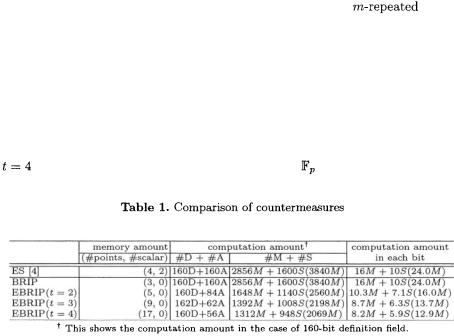
354 |
H. Mamiya, A. Miyaji, and H. Morimoto |
|
We note that EBRIP can fully make use of the technique of |
elliptic |
|
curve doublings [11] although it computes from MSB. Because pre-computation of base points requires  elliptic curve doublings.
elliptic curve doublings.
BRIP |
can compute dP in the computation amount of 160D + 160A with |
3 points. |
The computation amount in each bit is 24.0M, which is the same as |
that of ES. EBRIP with  can compute dP in the computation amount of 160D + 84A with 5 points. The computation amount in each bit is 16.0M, which is reduced to only 66% of ES. EBRIP with
can compute dP in the computation amount of 160D + 84A with 5 points. The computation amount in each bit is 16.0M, which is reduced to only 66% of ES. EBRIP with  can execute dP in the computation amount of 160D+56A with 17 points. In this case, the computation amount in each bit is 12.9M, which is reduced to only 54% of ES. Note that
can execute dP in the computation amount of 160D+56A with 17 points. In this case, the computation amount in each bit is 12.9M, which is reduced to only 54% of ES. Note that
is the fastest when the size of definition filed |
is 160. |
5Concluding Remarks
In this paper, we have presented countermeasures of BRIP and EBRIP that are resistant against RPA, ZPA, DPA, and SPA. Our countermeasure BRIP does not require any pre-computed table and can get dP in the computation of approximately 24.0 M in each bit. EBRIP with  can get dP in the computation of approximately 12.9 M in each bit with using a pre-computed table and one more point of 17 points in total. Both RPA and ZPA are easily applied to the hyper elliptic curve cryptosystems because a divisor in a hyper elliptic curve consists of more than two parts, some of which would happen to become 0. Our countermeasure improves the addition-chain itself and not use a specific feature of an elliptic curve such as a coordinate system. Therefore, BRIP and EBRIP can also be generalized to deal with hyper elliptic curve cryptosystem. We will describe BRIP and EBRIP on a hyper elliptic curves and discuss the efficiency in our final paper.
can get dP in the computation of approximately 12.9 M in each bit with using a pre-computed table and one more point of 17 points in total. Both RPA and ZPA are easily applied to the hyper elliptic curve cryptosystems because a divisor in a hyper elliptic curve consists of more than two parts, some of which would happen to become 0. Our countermeasure improves the addition-chain itself and not use a specific feature of an elliptic curve such as a coordinate system. Therefore, BRIP and EBRIP can also be generalized to deal with hyper elliptic curve cryptosystem. We will describe BRIP and EBRIP on a hyper elliptic curves and discuss the efficiency in our final paper.
References
l.K. Araki and T. Satoh “Fermat quotients and the polynomial time discrete log algorithm for anomalous elliptic curves”, Commentarii Math. Univ. St. Pauli., vol. 47 (1998), 81–92.
TEAM LinG
Efficient Countermeasures Against RPA, DPA, and SPA |
355 |
2.T. Akishita and T. Takagi, “Zero-value Point Attacks on Elliptic Curve Cryptosystem”, ISC2003, Lecture Notes in Computer Science, 2851(2003), Springer-Verlag, 218–233.
3.C. Clavier and M. Joye, “Universal exponentiation algorithm - A first step towards provable SPA-resistance –”, CHES2001, Lecture Notes in Computer Science, 2162(2001), Springer-Verlag, 300–308.
4.M. Ciet and M. Joye, “(Virtually) Free randomization technique for elliptic curve cryptography”, ICICS2003, Lecture Notes in Computer Science, 2836(2003), Springer-Verlag, 348–359.
5.H. Cohen, A. Miyaji and T. Ono, “Efficient elliptic curve exponentiation using mixed coordinates”, Advances in Cryptology-Proceedings of ASIACRYPT’98, Lecture Notes in Computer Science, 1514(1998), Springer-Verlag, 51-65.
6.J. Coron, “Resistance against differential power analysis for elliptic curve cryptosystem”, CHES’99, Lecture Notes in Computer Science, 1717(1999), SpringerVerlag, 292–302.
7.G. Frey and H. G. Rück, “A remark concerning  and the discrete logarithm in the divisor class group of curves”, Mathematics of computation, 62(1994), 865-874.
and the discrete logarithm in the divisor class group of curves”, Mathematics of computation, 62(1994), 865-874.
8.“Proposed federal information processing standard for digital signature standard (DSS)”, Federal Register, 56 No. 169, 30 Aug 1991, 42980–42982.
9.T. ElGamal, “A public key cryptosystem and a signature scheme based on discrete logarithms”, IEEE Trans. Inform. Theory, IT-31 (1985), 469–472.
10.L. Goubin, “A Refined Power-Analysis Attack on Elliptic Curve Cryptosystems”, PKC2003, Lecture Notes in Computer Science, 2567(2003), Springer-Verlag, 199– 210.
11.K. Itoh, M. Takenaka, N. Torii, S. Temma, and Y. Kurihara, “Fast implementation of public-key cryptography on DSP TMS320C6201”, CHES’99, Lecture Notes in Computer Science, 1717(1999), Springer-Verlag, 61–72.
12.K. Itoh, T. Izu, and M. Takenaka, “Efficient countermeasures against power analysis for elliptic curve cryptosystems”, SCIS2004, 2004 (previous version). The final version will be appeared in the proceedings of CARDIS 2004.
13.M. Joye and C. Tymen, “Protections against Differential Analysis for Elliptic Curve Cryptosystem”, CHES2001, Lecture Notes in Computer Science, 2162(2001), Springer-Verlag, 377–390.
14.N. Koblitz, “Elliptic curve cryptosystems”, Mathematics of Computation, 48 (1987), 203–209.
15.C. Kocher, “Timing attacks on Implementations of Diffie-Hellman, RSA, DSS, and other system”, CRYPTO’96, Lecture Notes in Computer Science, 1109(1996), Springer-Verlag, 104–113.
16.C. Kocher, J. Jaffe, and B. Jun, “Differential power analysis”, Crypto’99, Lecture Notes in Computer Science, 1666(1999), Springer-Verlag, 388-397.
17.D. E. Knuth, The Art of Computer Programming, Vol. 2: Seminumerical Algorithms, 2nd ed., Addison-Wesley, 1981.
18.K. Koyama and Y. Tsuruoka, “Speeding up elliptic cryptosystems by using a signed binary window method”, Advances in Cryptology-Proceedings of Crypto’92, Lecture Notes in Computer Science, 740 (1993), Springer-Verlag, 345–357.
19.A. Menezes, T. Okamoto and S. Vanstone, “Reducing elliptic curve logarithms to logarithms in a finite field”, Proceedings of the 22nd Annual ACM Symposium on the Theory of Computing (1991), 80–89.
TEAM LinG
